The Gordon Bennett Balloon Race: A Legacy of Adventure, Fame, and Endurance
The Gordon Bennett Balloon Race, conceived by the adventurous Gordon Bennett, owner of the New York Herald, in 1906, stands as a monumental chapter in the annals of aviation. This race wasn’t just about flying; it was about pushing the limits of endurance and strategy in the sky.
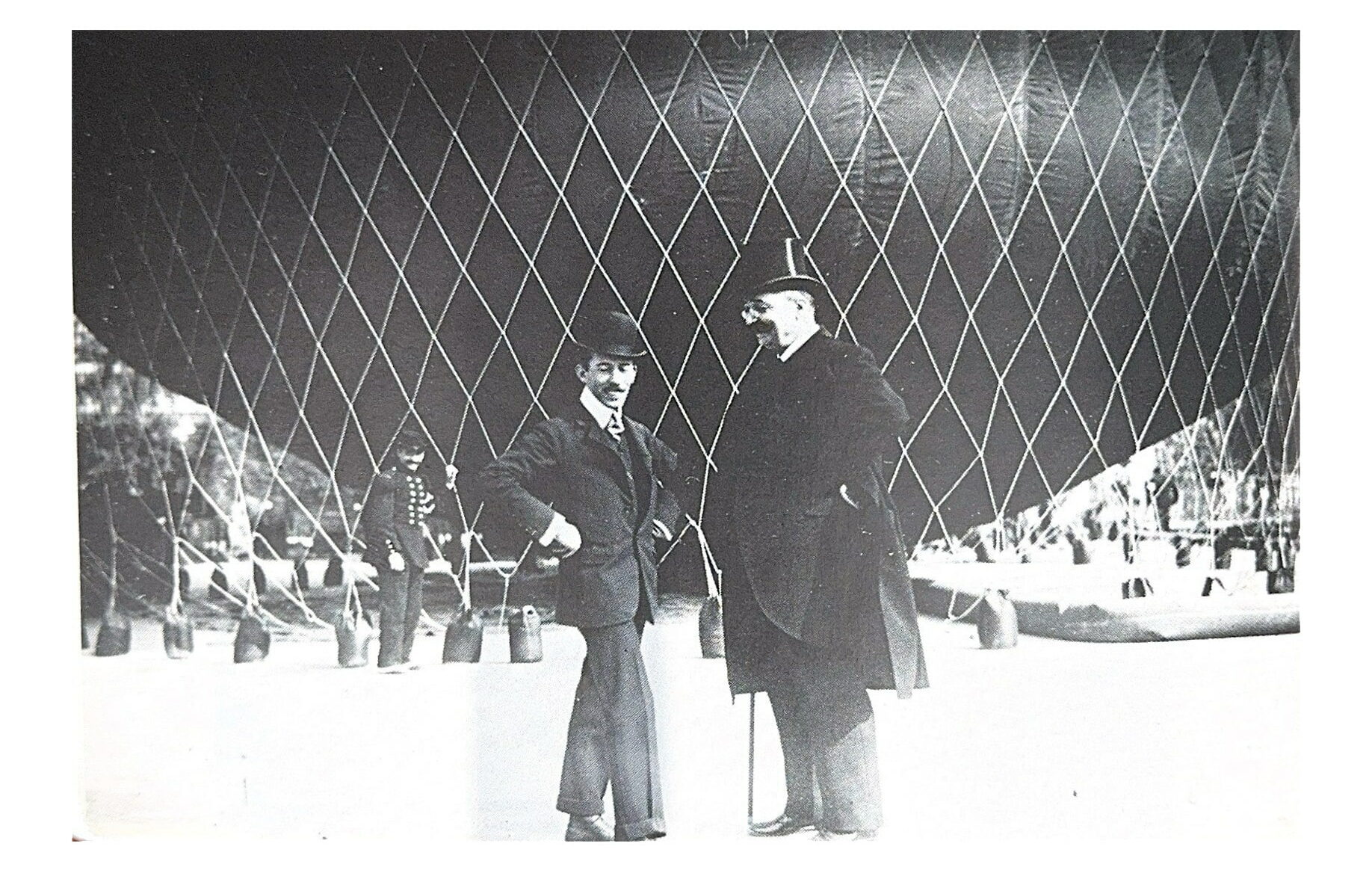
The Objective Of The Balloon Race
The primary goal of the Gordon Bennett race was breathtakingly straightforward yet challenging: to fly a lighter than air aircraft the longest distance from the launch point. The intrigue lay in the fact that pilots did not know their final destination in advance. This uncertainty, coupled with the need to stay airborne for potentially several days, made the race a thrilling test of endurance and skill.
The Illustrious Participants
This international contest of endurance and strategy became a magnet for celebrities and pioneers. Among the notable participants were editors like Holland Forbes of Forbes Magazine, automotive giants like Rolls of Rolls-Royce, M. Honeywell, and even aviation legends like Santos-Dumont, known for inventing the first plane with an engine. Their involvement added a layer of glamour and prestige to the race, elevating it from a mere sporting event to a symbol of human aspiration and ingenuity.
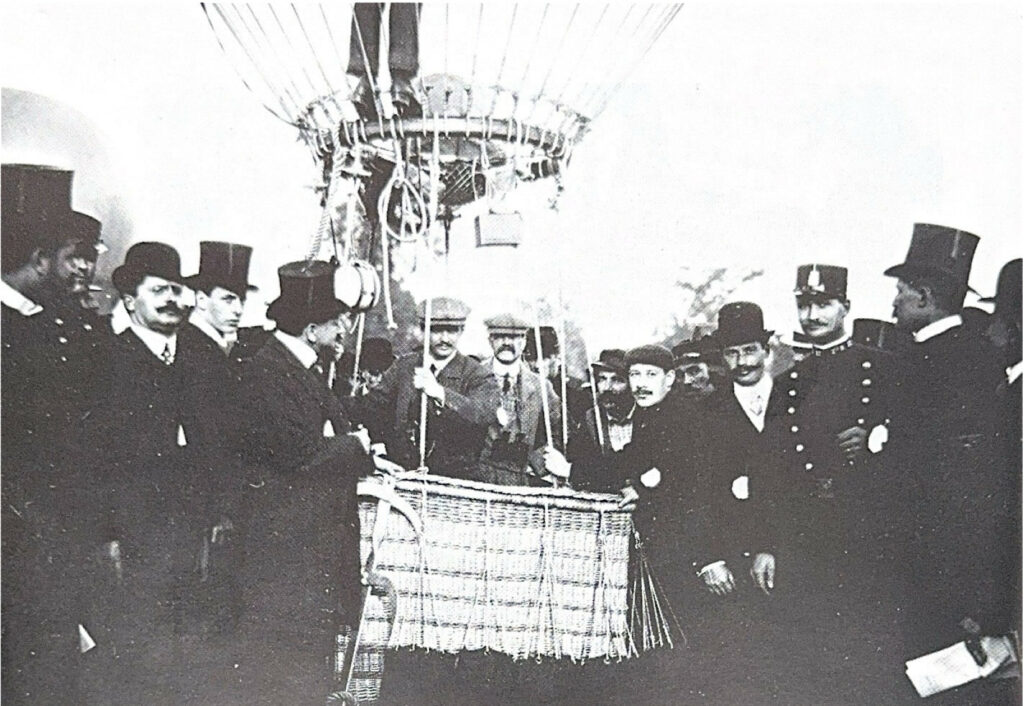
The Race’s Unique Challenges
Gas balloon racing is as unique as its participants. Unaware of where or when the race would end, balloon competitors embarked on a journey filled with uncertainty and excitement. This element of the unknown was a critical factor in the race’s widespread popularity.
How To Control The Direction Of Gas Balloons
Gas-filled balloons operate on a simple principle yet deeply nuanced in practice. These balloons are filled with a gas that is lighter than air, such as hydrogen or helium. This lighter-than-air quality provides the lift, allowing the balloon to ascend into the sky.
However, unlike aircraft with engines, balloons do not have a steering wheel to control their direction. The only way to navigate a gas balloon is by moving vertically and finding air currents moving in different directions at different altitudes. This vertical movement is achieved through a delicate balance of ascent and descent, managed by manipulating the balloon’s buoyancy.
To ascend, pilots release ballast, usually in the form of sandbags. This decreases the balloon’s overall weight, allowing it to rise. To descend, pilots release some of the gas through a valve at the top of the envelope. This action reduces the balloon’s lift, causing it to gently lower.
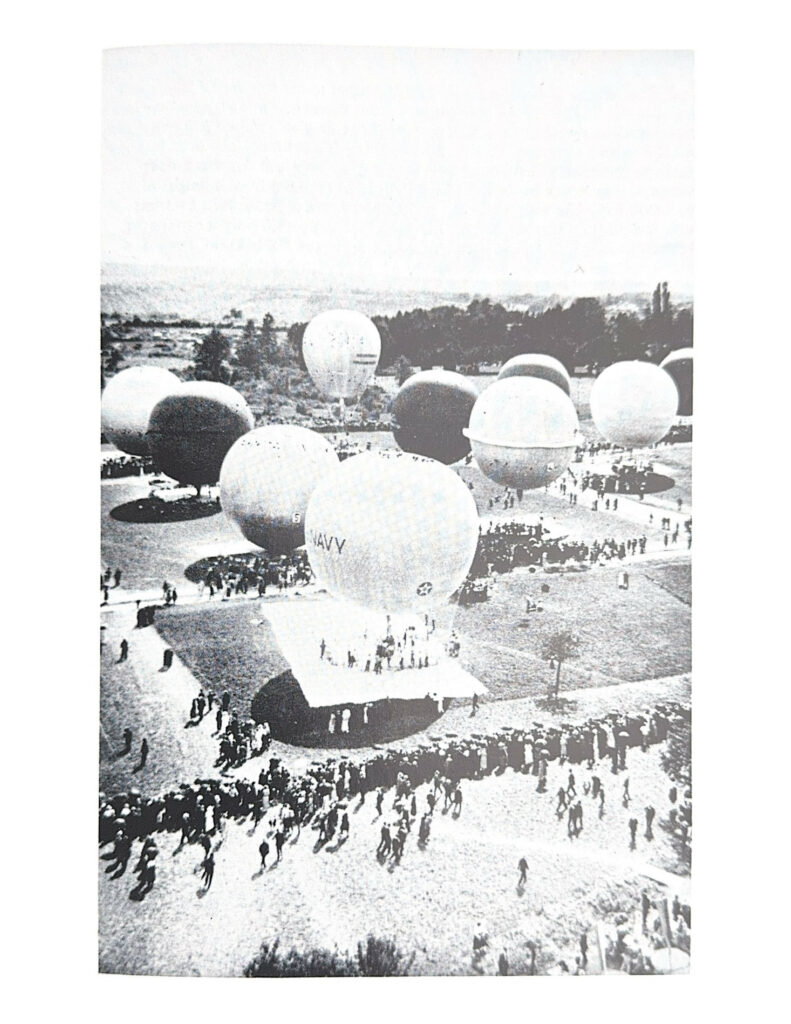
Navigating the Winds
The pilot’s skill lies in reading the wind patterns and understanding how different altitudes offer different wind directions and speeds. Pilots can indirectly steer their course by ascending or descending into these varying air currents. This navigation method requires a deep understanding of meteorology and a keen sense of the environment.
Competitors had to be prepared for long flights, with the record being an astonishing 73 hours in 1908. They carried essential survival gear, food for three days, and navigational equipment. Every two hours, they dropped envelopes addressed to the Aero Club of France to document their journey and released carrier pigeons.
The Gordon Bennett Balloon Race was more than a mere competition; it was a historic ballooning event and the celebration of human daring, a testament to the relentless pursuit of adventure and a gathering of some of the most remarkable figures of the era.
First Hot Air Balloon Competition
The Dawn of Competitive Hot Air Ballooning: The St. Paul Winter Carnival
The St. Paul Winter Carnival in the early 1960s marked the beginning of modern hot air balloon competitions and showcased the remarkable feats of pioneering spirit and ingenuity.
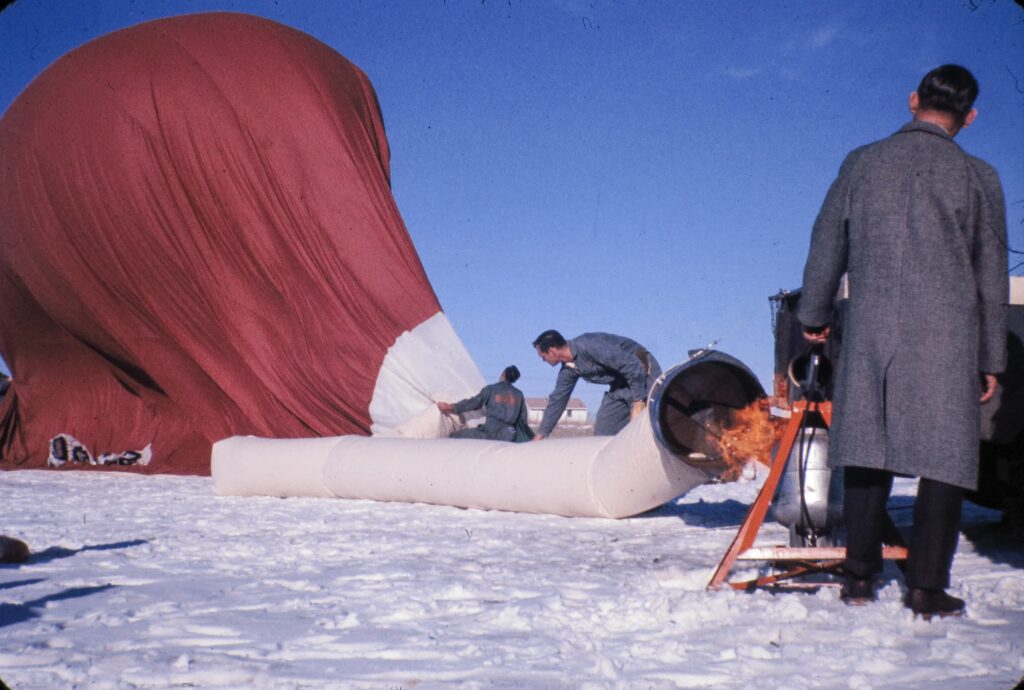
The Inaugural Hot Air Balloon Race
In this groundbreaking event, on Jan 28th, 1962, only three balloons took to the skies, piloted by individuals who were about to etch their names in the annals of ballooning history. The challenge was straightforward yet daunting: to launch from a common point and land as close as possible to a set target. The pilot closest to the target would receive the highest score and win a trophy presented by the famous stratospheric aeronaut Augustus Piccard on his 78th birthday!
The Underdog Triumphs
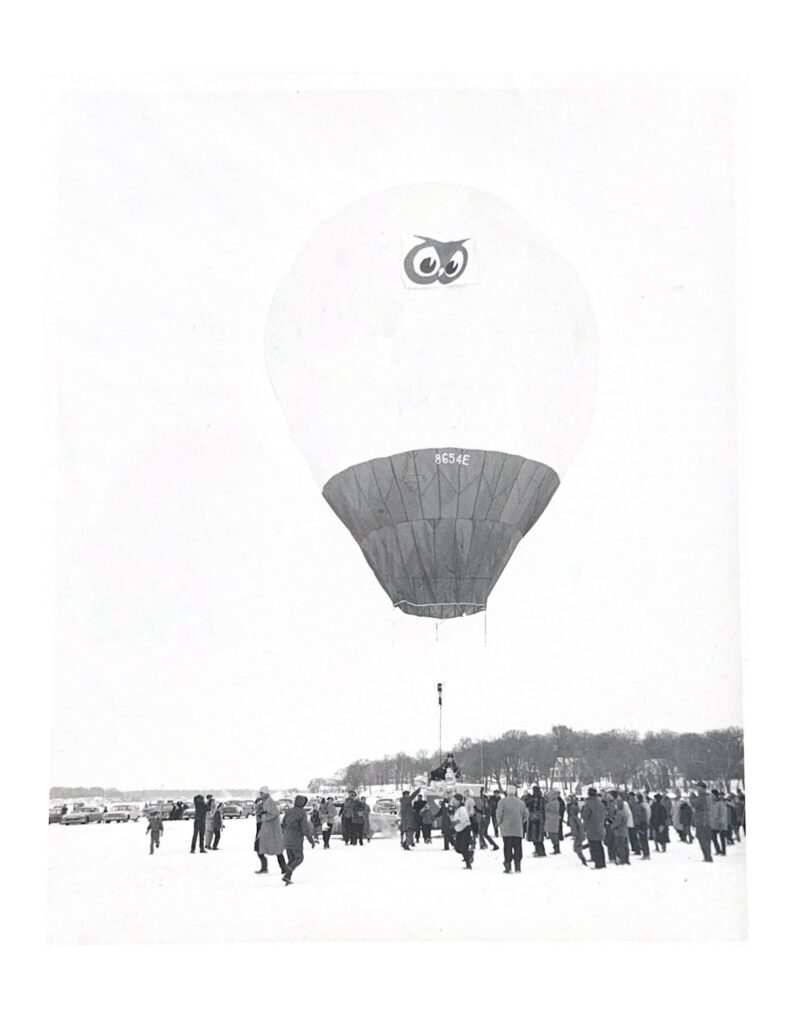
Flying a balloon crafted from war surplus parachutes and using a lawn chair as his basket, Tracy Barnes emerged as an unlikely hero. Against all odds, Barnes managed to land his makeshift balloon a mere 200 feet from the target. This remarkable feat was even more impressive, considering his closest competitor was almost half a mile away.

The Rivals: Piccard and Yost
Barnes’ competitors, Don Piccard and Ed Yost, were seasoned professionals in balloon construction, having been involved in the field since the late 1940s. They entered the competitive ballooning competition with superior equipment and a wealth of experience. Yet, it was Barnes, with his rudimentary balloon and unconventional approach, who clinched the victory.
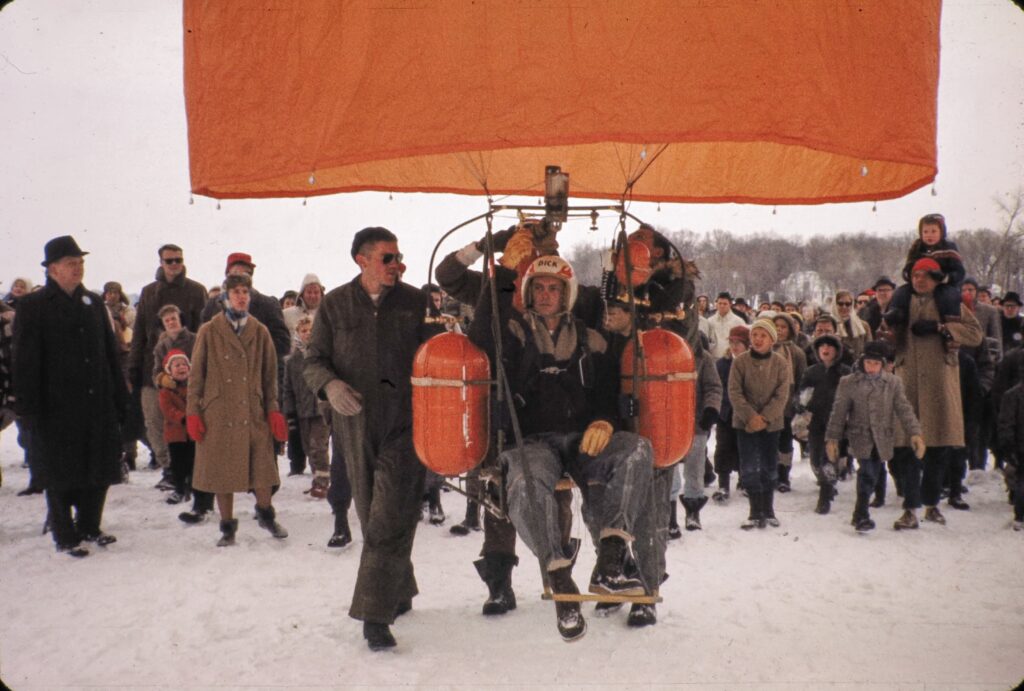
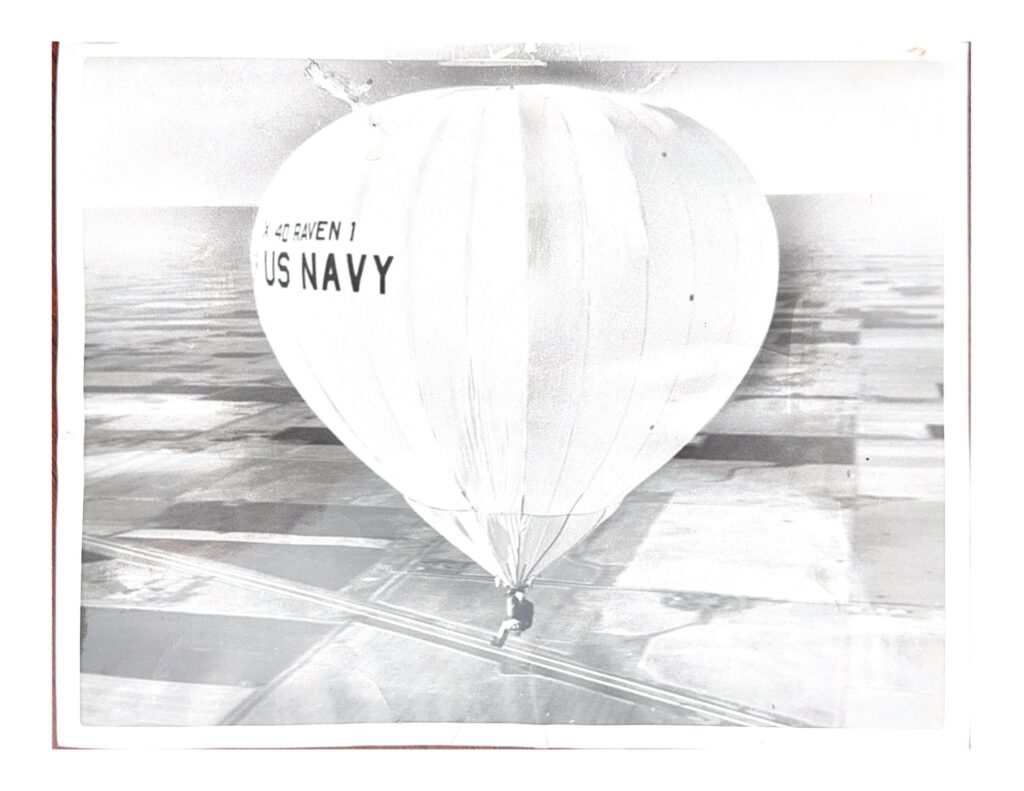
The Significance of Barnes’ Victory
Barnes’ win at the St. Paul Winter Carnival was more than just a triumph of distance; it was a victory of ingenuity and daring. His journey was marked by a whimsical moment when he descended to ask spectators for directions as he couldn’t see the target. Spectators gave him general directions, and he happily ascended. The race underscored the fact that skill and a deep understanding of the winds often trumped technological superiority in the realm of hot air ballooning.
The Evolution of Hot Air Balloon Competitions
This inaugural race set the stage for the future of hot air balloon competitions. It demonstrated the potential for precision and strategy in a sport where pilots are at the mercy of the winds, guiding their balloons to the target with no direct steering mechanism. The competition division of the Balloon Federation Of America was born.
From 1960 to 1970, there were 35 hot air balloon competitions across the United States which brought a new aspect to balloon flying. To be competitive, pilots learned to use topographical features for navigational precision as well as consistent upper-level winds.
One of the most daring and fascinating competitions of the 1960s was the Catalina Balloon Race. Pilots from all across the country came out for the event to see who could fly from Catalina Island back to the mainland (Los Angeles) first! Out of the nine competitors, only one made it, Mr. Ed Yost.
The Intricacies of Modern Hot Air Balloon Competitions
Modern hot air balloon competitions blend skill, strategy, and a deep understanding of the environment. These competitions, governed by the Fédération Aéronautique Internationale (FAI) rules, are far more complex and demanding than the serene image of ballooning might suggest.
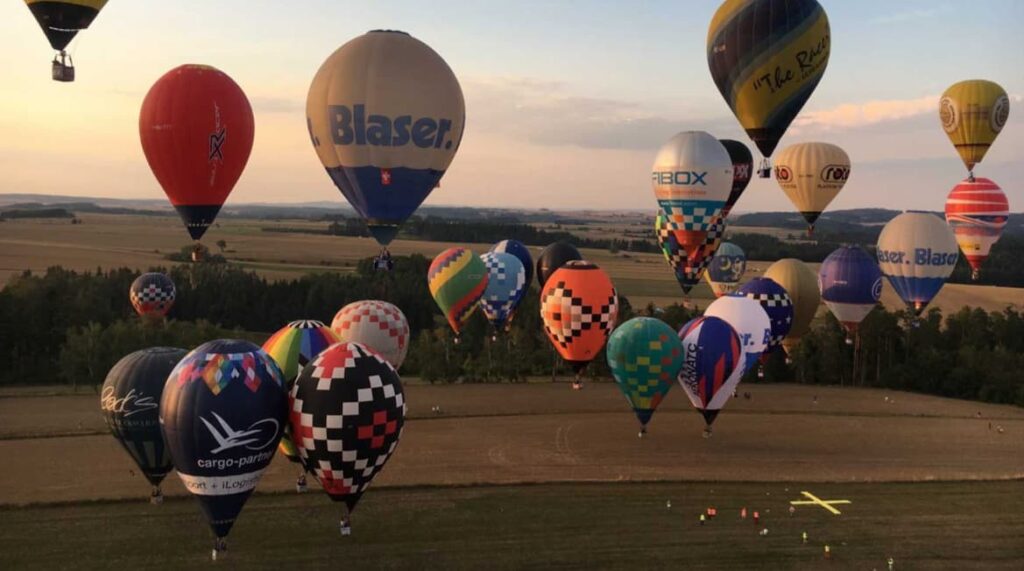
Hot air balloon competitions uniquely combine elements of various sports, requiring a blend of technical skills and strategic thinking. Similar to golf, pilots must demonstrate precision in dropping markers onto specific targets from the air. The competitions often feature a large number of balloons, akin to NASCAR’s dense, competitive fields, creating dynamic and challenging flying environments. Like sailing, where sailors adjust sails to navigate, balloon pilots rely solely on vertical movements to find wind currents for directional control, as balloons lack steering mechanisms. This combination of precision, crowded competition, and reliance on natural elements for navigation defines the technical and strategic complexity of balloon racing.
The Competitive Ballooning Landscape
Hot air ballooning competitions occur at various levels, including national, regional, international, and world championships, with World Championships held biennially. These events span several days, often with two flights per day, each consisting of a series of tasks set by the Director based on weather conditions and other factors.
The Essence of Balloon Competition
Unlike other sports, competitive flying competitions don’t focus on speed, distance, or altitude. Instead, they require pilots to maneuver their balloons over a course with specific goals, targets, scoring areas, and time and distance limits. Success hinges on flight planning, anticipation, and managing the balloon in given weather conditions.
The Structure of Balloon Competition Flights
In these competitions, each flight typically comprises 4-6 distinct tasks. These tasks are designed to test a range of piloting skills, from precise navigation to strategic planning. The complexity of these tasks varies depending on the level of competition, with World Championship events featuring more challenging and intricate tasks.
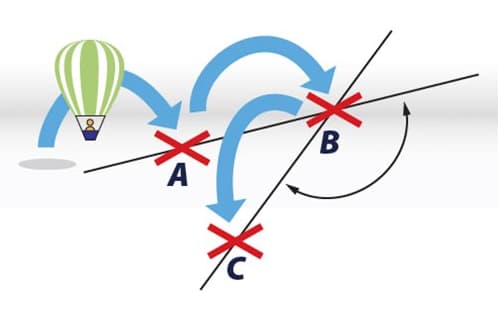
Escalating Complexity at the World Level
At the world championship level, the tasks are numerous and layered with additional challenges and complications. These might include more complex wind patterns, challenging terrain, or tighter time constraints. The tasks are designed to push the pilots’ abilities to their limits, requiring a deep understanding of balloon mechanics, wind dynamics, and strategic flight planning.
Key Factors In Balloon Competition
Catching the Wind: Pilots must understand and predict wind patterns at various altitudes.
Orientation in Space: Spatial awareness is crucial, requiring pilots to constantly know their position, the target’s location, and other balloons.
Teamwork: A coordinated effort between the pilot and ground crew is essential for information exchange and successful navigation.
Self-Control and Physical Ability: Pilots must maintain composure and precision in operating the burner and vent to control the balloon.
Balloon Competition Scoring System
The scoring is proportional, with the task winner receiving 1,000 points and others scoring less based on their performance. The overall winner is the pilot with the most points accumulated throughout the competition.
Types Of Competition Tasks:
Pilot Declared Goal (PDG): Pilots declare their goal selection before take-off and aim to drop a marker as close as possible to it.
Judge Declared Goal (JDG): The Director sets the goal, and pilots aim to drop their marker near it.
Hesitation Waltz (HWZ): Pilots choose one of several goals set by the Director.
Fly In (FIN): Pilots select their launch point and aim for a target set by the Director.
Fly On (FON): Pilots declare their goal during flight based on the direction in flight and aim to drop their marker near it.
Hare and Hounds (HNH): Pilots follow a ‘hare’ balloon and aim to drop their marker near its landing spot.
Watership Down (WDN): A combination of JDG and HNH, where pilots follow a ‘hare’ balloon and aim for its landing spot.
Gordon Bennett Memorial (GBM): Pilots aim to drop their marker within a scoring area close to a set goal.
Calculated Rate of Approach Task (CRT): Pilots aim to drop their marker within a time-valid scoring area near a set goal.
Elbow (ELB): Pilots aim to achieve the most significant change in flight direction.
Land Run (LRN): Pilots aim to cover the most significant area possible.
Angle (ANG): Pilots aim for the most significant deviation from an initial direction.
Minimum Distance (MDD): Pilots drop markers in scoring areas to achieve the shortest distance between them.
Maximum Distance Double Drop (XDD): Similar to MDD, but aiming for the longest distance between markers.
3D Shape Task (3DT): Pilots aim to cover the most significant distance within a defined airspace.
The Role Of The Competition Director
The Director of the Competition is pivotal, providing task sheets and adjusting them based on weather and terrain. They also define targets and goals, which can be physical objects or coordinates.
Special Aircraft For Competing In Balloon Competition
Competitive hot air ballooning, a sport that combines the thrill of flight with the challenge of precise navigation, has evolved significantly over the years. Central to this evolution is the specialized equipment used by balloonists, particularly the type of balloon envelope known as a “racer.” This equipment is crucial for pilots who participate in competitions where precision and speed are key to success.
The Racer Balloon Envelope
Design and Shape: Unlike traditional round-shaped hot air balloons, racer balloons have a distinct elongated or tear-drop shape. This aerodynamic design is pivotal in reducing drag and allows for more efficient maneuvering in the air.
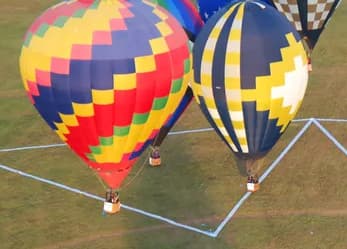
Speed in Altitude Adjustment: One of the most significant advantages of a racer balloon is its ability to increase and decrease altitude at a rate twice as fast as standard balloons. This rapid altitude change is essential in competitions, where pilots often need to make quick ascents and descents to hit specific targets or navigate through varied air currents.
Material and Construction: Racer balloons are often made from lightweight and heat-resistant materials, allowing for quicker heat transfer and better control over temperature inside the envelope. This contributes to the balloon’s agility and responsiveness.
Size Variations: Racers come in various sizes to accommodate different competition needs and pilot preferences. Smaller racers can ascend and descend more quickly, while larger ones may offer more stability and endurance.
Additional Equipment in Competitive Ballooning
Burners: High-performance burners are used in competitive ballooning. These burners are capable of producing a more intense flame, allowing for rapid heat generation and faster altitude changes.
Basket: The baskets in competitive balloons are often more compact and lightweight, designed for agility and minimal drag. They are equipped with instruments necessary for navigation and competition, such as altimeters, variometers, and GPS systems.
Instruments for Precision Flying: High-tech instruments, including GPS for tracking, altimeters for altitude measurement, and variometers for vertical speed indication, are crucial. Pilots also use radios for communication with ground crews and other competitors.
The Competitive Edge
While there is no strict requirement for pilots to use a racer balloon in competitions, those who opt for traditional round balloons often find themselves at a significant disadvantage. The agility, speed, and precision offered by racer balloons make them an almost indispensable tool in the competitive ballooning arena. The ability to swiftly navigate to targets and adapt to changing air currents can make the difference between winning and losing in this challenging sport.
The equipment used in competitive hot air ballooning, especially the racer balloon, represents a blend of advanced engineering and strategic design tailored to meet the demands of precision flying and rapid maneuvering. This specialized equipment not only enhances the competitive aspect of the sport but also underscores the skill and expertise required to excel in this unique and exhilarating form of aviation.
The Technology and Tools
Pilots use various tools, including traditional maps, GPS, and loggers (Balloon live sensor), to navigate and record flight paths. Markers, typically colorful weighted streamers, are crucial for scoring.
The Excitement of Competition
These tasks require pilots to use the winds at various altitudes to navigate toward goals and targets within set time and distance limits. The competition is intense, demanding, and exhilarating, adding a new dimension to the sport of ballooning.
In modern hot air balloon competitions, pilots combine an aviator’s skills with a chess player’s strategic thinking. It’s a sport where the sky is not just a canvas for flight but a battlefield of wits and precision.
